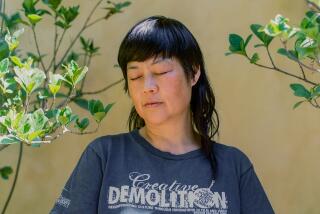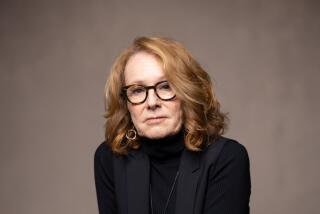Work of a higher order
- Share via
Patty CHANG has moved mountains, literally. But that’s only one part of “Shangri-La,” the New York-based artist’s new video installation and sculptural work on exhibit at the UCLA Hammer Museum in Westwood.
“Shangri-La,” which centers in part around the artist’s attempts to have a mirrored sculpture of a mountain built in south central China, started with an unusual story that Chang stumbled across on the Internet. In 1997, the Chinese rural farming village of Zhongdian proposed changing its name to Shangri-La (after the mythical land described in James Hilton’s 1933 novel, “Lost Horizon”) in the hope of attracting tourists.
The name change proved irresistible to roughly a dozen other towns in the area. They all attempted to adopt the Shangri-La name, and the resulting controversy had to be resolved by the Chinese government.
Zhongdian won the battle, but to appease the other towns, a larger region at the foot of the Meili Snow Mountain was named the China Shangri-La Ecological Tourism Zone.
Intrigued by the town’s determination to make an imaginary place real, Chang, whose work has been exhibited at the Guggenheim and the Seattle Art Museum, decided to visit. In the meantime, she discovered that her parents were scheduled to take a tour the following year.
“I really wanted to go with them and this bunch of 65-year-old Chinese immigrants to the place where, according to the myth, you live forever,” Chang says with a laugh.
Ultimately, the tour was canceled because of the epidemic of severe acute respiratory syndrome, or SARS, but Chang continued to research the region.
When she was finally able to make the trip to Zhongdian in 2004, Chang found a wealth of material for her 40-minute video. As in “Lost Horizon,” the renamed town of Shangri-La has a mountain as its centerpiece.
Considered sacred by the townspeople, the mountain’s image pops up in murals, signage and conversation. “I just kept seeing it,” says Chang. “It’s sort of a religious symbol, but also this kitsch tourism symbol. So I started creating the mountain” as an artwork.
She chose to build the sculpture out of fragmented mirrors, giving it not only a disco ball effect to reflect the consumerism of the area but also a reference to the looking glass’ symbolism as entree to a more spiritual realm. Instead of doing the work herself, she hired local citizens.
Focusing her camera on the townspeople as they crafted the mountain as both 5-foot-tall sculpture (a larger version of which is on exhibit) and as a separate, fantastical birthday cake at the local bakery allowed Chang, who began her career as a performance artist, to take a smaller role in the project.
“Originally I was thinking I didn’t want this to be like an ethnographic study, but when I got there I realized the interactions with the townspeople were the only ways to combine the ideas of a real place and a fantasy place,” Chang explains.
From off camera, Chang negotiates with bakers struggling to frost an increasingly lumpy cake and offers suggestions as an architect and a monk brainstorm ideas for the mountain sculpture (a plastic foam base is eventually discarded in favor of plywood). Chang also builds a faux oxygen pressure chamber, then invites the monks to enter. “It made sense to put the monks in the pod because they’re almost like conduits between heaven and Earth,” Chang says.
Chang does play a small role in the video, posing as a blushing bride for Taiwanese-style fantasy wedding photography. “It’s a really big thing there,” says Chang. “You go, put on a wedding dress and get photographed in these scenic environments. It fit the piece, since it’s about constructing this romantic idea, this fantasy, about love and marriage. But in the last couple of years, I’ve really tried to incorporate other people into my work so I can step out of it and look at it.”
To Hammer chief curator Russell Ferguson, this represents an intriguing new direction for Chang. “I think she’s going through a process that a lot of people who are performers go through in moving beyond using themselves as the center of their work,” he says. “She’s finding ways to pursue some of the same issues in a very interesting way.”
Chang is probably best known for her performance art, which has often dealt with issues of gender and physicality in bold, and sometimes shocking, ways. In 2002’s “Stage Fright,” she challenged audiences by binging and purging in a bathroom stall while watching Hitchcock’s 1950 movie of the same name. She later re-created the performance using USC sorority members in “Sorority Stage Fright.”
In 1998’s “Candies,” she made a wry comment on female passivity by donning a business suit, clamping her mouth open with a dental device and filling her mouth with peppermints, allowing drool to puddle on the floor in front of her.
The Hammer Museum commissioned this latest work as part of the Three M Project, a collaboration of the Hammer, the New Museum of Contemporary Art in New York and the Museum of Contemporary Art in Chicago. The museums worked together to co-present the work of emerging artists, who are each awarded $50,000 to cover expenses. Others chosen for the project include video artists Fiona Tan and Aernout Mik.
Chang will have little time to enjoy her installation. Because the New York and L.A. exhibits overlap, a new mirrored mountain must be built for the East Coast. If it’s a little slapdash, that’s the point. “It’s supposed to have that weird sense of being kitschy and commercial but handmade. You’re supposed to see the cracks in the mirror and the mechanism underneath.”
*
Artist abroad
Shangri-La
Where: UCLA Hammer Museum, 10899 Wilshire Blvd., Westwood.
When: Tuesday, Wednesday, Friday, Saturday, 11 a.m.-7 p.m.; Thursday, 11 a.m. -- 9 p.m.; Sunday, 11 a.m. -- 5 p.m. Closed Mondays. Now-Oct. 16.
Price: Free admission through Sept. 4. Starting Sept. 6, $5 for adults, $3 for seniors and free on Thursdays.
Info: (310) 443-7000
More to Read
The biggest entertainment stories
Get our big stories about Hollywood, film, television, music, arts, culture and more right in your inbox as soon as they publish.
You may occasionally receive promotional content from the Los Angeles Times.










